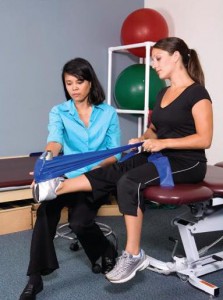Managing Fibromyalgia with Exercise and Physical Therapy
Treatment for fibromyalgia focuses on breaking the cycle of pain and decreased physical activity due to flare-ups. Home treatments, especially  exercise and improving sleep, are usually the most critical methods of coping with the symptoms and pain from fibromyalgia.
exercise and improving sleep, are usually the most critical methods of coping with the symptoms and pain from fibromyalgia.
Regular exercise will help strengthen your muscles, thereby increasing blood flow to the muscles, promoting healing, and increasing your endurance. It also may reduce your risk of additional pain from tiny muscle injuries. Exercise also seems to increase the amount of pressure that a person can tolerate at weak or painful body points.
Myofascial Release, a therapeutic massage that gently manipulates the fascia, or connective tissue that covers the body like a web, can also help fibromyalgia sufferers by relieving excessive pressure on nerves, muscles, and blood vessels. This therapeutic massage can also help restore lost motion.
Developing an Exercise Routine
Mild to moderate exercise is appropriate for most people suffering from fibromyalgia. A balanced exercise program for should include:
- Low-impact aerobic exercise, such as walking, swimming, biking, or water aerobics. This is the most helpful type of exercise for people who have fibromyalgia, because it builds general strength and endurance.
- Stretching exercises, which can help relax tight muscles and ease spasms.
- Strengthening exercises to build stronger muscles.
The key is to a successful work-out routine is to build exercise habits that you practice over the long term. Here are some tips for starting and staying with a good exercise program:
- Start slowly.
Many people with fibromyalgia have been inactive for a long time because of fatigue and pain and should not start a vigorous exercise program. Over-exerting yourself may make your symptoms worse.- If 3 to 5 minutes of activity are all you can manage at first, just do that.
- When you’re ready, try to exercise a little longer at a time. Increase slowly until you can exercise for 10 minutes at a time.
- Build up your exercise program.
Bit by bit, you should aim for at least 2½ hours a week of moderate exercise. It’s fine to be active in blocks of 10 minutes or more throughout your day and week. - Stretch before and after you exercise.
This may improve flexibility, maintain good posture, and prevent injury. Stretch slowly and gently. Do not bounce, but keep a gentle pull on the muscle. - Keep track of your exercise by making a chart or diary that fits your needs.
You may want to include what exercise you did, how long you did it, how hard you think you worked at it, and how you felt during and after the exercise. This will help you see your progress and will also allow you to advance or change your exercise program over time. - Stay with it.
When you have a flare-up of your symptoms, do not stop exercising. Instead, cut back slightly. Try to build up to your regular routine as soon as possible so that you don’t lose any of the benefits you’ve gained.
Moderate activity is safe for most people, but you should always talk to your doctor before you start an exercise program.
+ Learn more about Myofascial Release.
+ Find a Certified Personal Trainer who can develop a customized work-out program for you.

